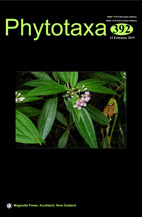Abstract
Phyllachora species usually cause leaf tar spot disease associated with living leaves in various hosts. In this study, a sample of stem tar spot was collected from a Phyllostachys heteroclada forest in Ya’an City, Sichuan Province, China. Here we introduce a new taxon in the genus Phyllachora through using morphology, information on host and multigene phylogeny of three genes (LSU, SSU, ITS). Within the family Phyllachoraceae, members of the genus Phyllachora form five groups with maximum likelihood and Bayesian phylogenies. The new species Phyllachora heterocladae clusters with eight undetermined Phyllachora species in a highly supported clade and morphologically differs from other similar species in having relatively long asci with a noticeable apical ring, fusiform to ellipsoid ascospores with many guttules and a thick gelatinous sheath and botuliform or falciform spermatia with 1-septate or aseptate.

